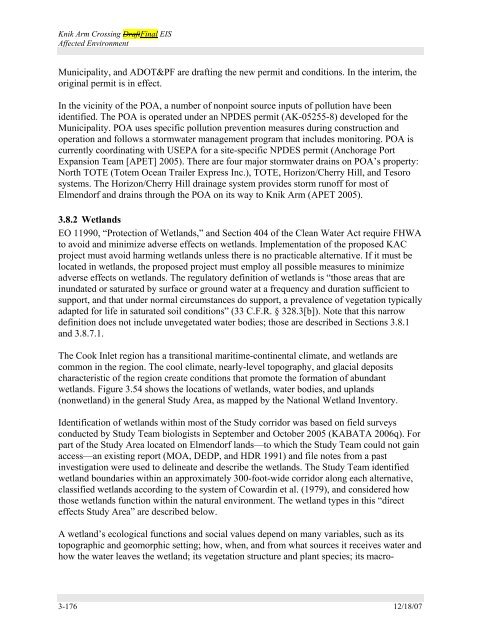3.0 Affected Environment - Knik Arm Bridge and Toll Authority
3.0 Affected Environment - Knik Arm Bridge and Toll Authority
3.0 Affected Environment - Knik Arm Bridge and Toll Authority
Create successful ePaper yourself
Turn your PDF publications into a flip-book with our unique Google optimized e-Paper software.
<strong>Knik</strong> <strong>Arm</strong> Crossing DraftFinal EIS<br />
<strong>Affected</strong> <strong>Environment</strong><br />
Municipality, <strong>and</strong> ADOT&PF are drafting the new permit <strong>and</strong> conditions. In the interim, the<br />
original permit is in effect.<br />
In the vicinity of the POA, a number of nonpoint source inputs of pollution have been<br />
identified. The POA is operated under an NPDES permit (AK-05255-8) developed for the<br />
Municipality. POA uses specific pollution prevention measures during construction <strong>and</strong><br />
operation <strong>and</strong> follows a stormwater management program that includes monitoring. POA is<br />
currently coordinating with USEPA for a site-specific NPDES permit (Anchorage Port<br />
Expansion Team [APET] 2005). There are four major stormwater drains on POA’s property:<br />
North TOTE (Totem Ocean Trailer Express Inc.), TOTE, Horizon/Cherry Hill, <strong>and</strong> Tesoro<br />
systems. The Horizon/Cherry Hill drainage system provides storm runoff for most of<br />
Elmendorf <strong>and</strong> drains through the POA on its way to <strong>Knik</strong> <strong>Arm</strong> (APET 2005).<br />
3.8.2 Wetl<strong>and</strong>s<br />
EO 11990, “Protection of Wetl<strong>and</strong>s,” <strong>and</strong> Section 404 of the Clean Water Act require FHWA<br />
to avoid <strong>and</strong> minimize adverse effects on wetl<strong>and</strong>s. Implementation of the proposed KAC<br />
project must avoid harming wetl<strong>and</strong>s unless there is no practicable alternative. If it must be<br />
located in wetl<strong>and</strong>s, the proposed project must employ all possible measures to minimize<br />
adverse effects on wetl<strong>and</strong>s. The regulatory definition of wetl<strong>and</strong>s is “those areas that are<br />
inundated or saturated by surface or ground water at a frequency <strong>and</strong> duration sufficient to<br />
support, <strong>and</strong> that under normal circumstances do support, a prevalence of vegetation typically<br />
adapted for life in saturated soil conditions” (33 C.F.R. § 328.3[b]). Note that this narrow<br />
definition does not include unvegetated water bodies; those are described in Sections 3.8.1<br />
<strong>and</strong> 3.8.7.1.<br />
The Cook Inlet region has a transitional maritime-continental climate, <strong>and</strong> wetl<strong>and</strong>s are<br />
common in the region. The cool climate, nearly-level topography, <strong>and</strong> glacial deposits<br />
characteristic of the region create conditions that promote the formation of abundant<br />
wetl<strong>and</strong>s. Figure 3.54 shows the locations of wetl<strong>and</strong>s, water bodies, <strong>and</strong> upl<strong>and</strong>s<br />
(nonwetl<strong>and</strong>) in the general Study Area, as mapped by the National Wetl<strong>and</strong> Inventory.<br />
Identification of wetl<strong>and</strong>s within most of the Study corridor was based on field surveys<br />
conducted by Study Team biologists in September <strong>and</strong> October 2005 (KABATA 2006q). For<br />
part of the Study Area located on Elmendorf l<strong>and</strong>s—to which the Study Team could not gain<br />
access—an existing report (MOA, DEDP, <strong>and</strong> HDR 1991) <strong>and</strong> file notes from a past<br />
investigation were used to delineate <strong>and</strong> describe the wetl<strong>and</strong>s. The Study Team identified<br />
wetl<strong>and</strong> boundaries within an approximately 300-foot-wide corridor along each alternative,<br />
classified wetl<strong>and</strong>s according to the system of Cowardin et al. (1979), <strong>and</strong> considered how<br />
those wetl<strong>and</strong>s function within the natural environment. The wetl<strong>and</strong> types in this “direct<br />
effects Study Area” are described below.<br />
A wetl<strong>and</strong>’s ecological functions <strong>and</strong> social values depend on many variables, such as its<br />
topographic <strong>and</strong> geomorphic setting; how, when, <strong>and</strong> from what sources it receives water <strong>and</strong><br />
how the water leaves the wetl<strong>and</strong>; its vegetation structure <strong>and</strong> plant species; its macro-<br />
3-176 12/18/07
















